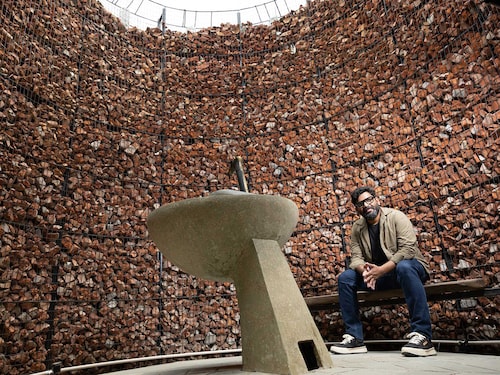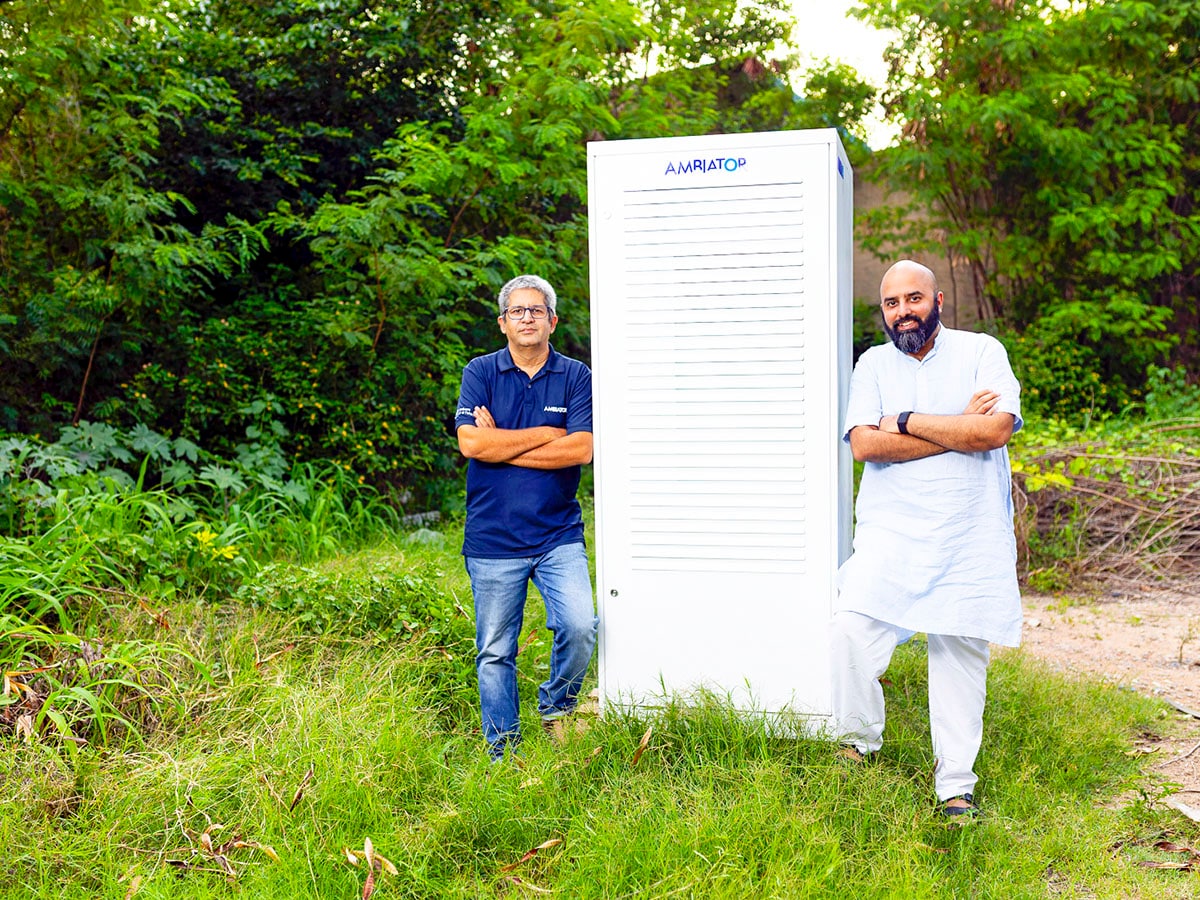Cooling homes without warming the planet
Companies are coming up with alternatives to air conditioners using traditional, natural cooling techniques which not only reduce carbon emissions but also reduce power bills


At the Hope Foundation building in Delhi, a faà§ade made of terracotta and louvers blocks the sun, keeping the house and surrounding spaces cooler. A similar structure covers the sides of Anupama, a courtyard house in Hyderabad that incorporates passive cooling design techniques on its south and west facade. The building is also proposed to be covered with a terracotta pitch roof to reduce heat-gain through from the top.
In an increasingly warming world, where, according to a 2023 International Energy Agency report India is projected to have more than a billion air conditioners in operation by 2050, people and companies are working towards adopting alternative solutions that not only reduce carbon emissions and more warming, but also reduce the power bills.
These include companies using traditional and natural cooling products like terracotta or khus to building energy-efficient cooling solutions, all designed to optimise energy consumption and minimise environmental impact.
Architecture firm CoolAnt uses the properties of terracotta in its facades for buildings, art sculptures as well as cooling towers in big buildings and public spaces. Started in Delhi NCR in 2017 by architect Monish Siripurapu, its products rely on clay-based cooling techniques and inspired by the structure of a beehive.
The structures incorporate water and terracotta, pouring water on the structure and circulating it so that the air that passes through hollow terracotta tubes cools the space and does not release hot air. It is a simple process customised with modern calibration techniques, the team points out.
The aim at CoolAnt, says Siripurapu, is to focus on reducing dependency on air conditioners through traditional and passive cooling methods. “Technically, a 60–70 percent reduction in energy costs is possible, but we aim for at least 40 percent," he adds.
Unlike air-conditioners, CoolAnt’s solution supports both closed and open spaces, with its combination of natural and mechanical ventilation, and evaporative cooling to reduce energy consumption to just 0–15 percent of what an air-conditioner would consume.
The system, which produces no polluting emissions, has won the National Energy Efficiency Innovation Award 2023 by the Bureau of Energy Efficiency, Government of India. The winning project—in which climate-responsive building envelopes were put on buildings in Jaipur’s Cantonment area—managed to reduce 1,33,000 kg CO2 emissions a year, according to Siripurapu.
"What CoolAnt does is visionary. The work they do isn’t just solutions to the current climatic problem, but it’s the lifestyle of the past that is well articulated for modern problems, making it a need to adapt for the future to come," says Pranayeeta Das from the education ministry of Jalpaiguri District. Das, who has seen CoolAnt’s facades at Vidya and Child NGO in Noida, is in charge of education of 100+ blocks in Jalpaiguri and CoolAnt will be helping with the renovation of a few schools that come under her supervision.
CoolAnt is currently working on 70 projects pan India and has previously worked on projects such as the Bhilai Commercial Complex, Hope Foundation, Delhi and Civil Lines Commercial Complex, Raipur.
The company has three categories of products. ‘Building Envelopes’ are built-in cooling systems for buildings that cost anywhere from Rs 400 to Rs 1500 per sq ft. Then there are pre-cooling systems built for cooling towers, blowers, and industrial applications to improve the efficiency of the already installed cooling towers where the fresh air inlet of the cooling towers is made to go through CoolAnt’s product. This ensures the compressor or cooling device does not have to do as much work to bring down the temperature in the place. The third is the cooling of public spaces using art installations, which serve the dual purpose of cooling the space and creating awareness about traditional systems.
“We have seen a tremendous response for the pre-cooling systems to decrease the load of artificial cooling towers by doing bulk cooling," says Siripurapu. CoolAnt pre-cooling systems also work well in glass faà§ade buildings, helping regulate the temperature. The company is bootstrapped and at a break-even point, with a plan to soon raise funds and expand, he adds.
For large commercial, industrial, and institutional spaces that need cooling, an option from startup Ambiator, founded in 2022, combines the cooling of air-conditioners with the energy efficiency of water coolers to provide fresh air without CFC emissions. The solution consumes 80 percent less energy, according to founder Jeeten Desai.
The process uses dewpoint regenerative cooling—a two-stage process ideal for hot, dry climates. First, outside air passes through a proprietary heat exchanger, cooling it without mixing with water. Then, the pre-cooled air flows through wet cellulose pads for further cooling. This method delivers AC-like performance while using up to 80 percent less electricity.
Though the basic technology is not new, and has been used in industrial cooling and large-scale applications for years, the founders modularised and automated it for wider accessibility. “It"s now an autonomous system that works on outdoor temperature and humidity states and modifies the way the unit needs to perform," says Desai.
Having started operations in 2022, Ambiator started selling its product only in 2023, and has sold 35 units so far. “It took us time to get our first product right and into the market. Full stack manufacturing in India is still a challenge, so we had to start from scratch all the way to building a commercial, ready product," says Desai.
The units, currently shipped to five states in the country—Rajasthan, Karnataka, Maharashtra, Telangana and Andhra Pradesh—come in one modular size of 5TR capacity, sufficient for cooling a space of 750 sq ft. but are scalable to any capacity combining multiple Ambiator modules.
Operating on a B2B model, the company currently serves six clients, including Mahindra LifeSpaces, Selco Foundation, Brigade Group, Mapro, and RN Filters who use the technology mostly in industrial spaces like factories and commercial spaces like complexes and shopping centres, along with a few individual customers.
 Tiger Aster (left) & Jeeten Desai (right), Co-Founders, Ambiator, Hyderabad. Ambiator"s eco-friendly cooling solution delivers 100% fresh air unlike conventional ACs, with lower costs and environmental impactImage: Vikas Chandra Pureti for Forbes India
Tiger Aster (left) & Jeeten Desai (right), Co-Founders, Ambiator, Hyderabad. Ambiator"s eco-friendly cooling solution delivers 100% fresh air unlike conventional ACs, with lower costs and environmental impactImage: Vikas Chandra Pureti for Forbes India
Unlike air-conditioners, CoolAnt’s facades support both closed and open spaces and unlike air coolers and ACs which recirculate or filter air, the facade provides open fresh air, enhancing air quality naturally.
The facade also supports planter integration, is customisable, and is made from sustainable materials. Considering there are no chemical refrigerants, there is very little environmental impact. And post its life cycle, the facade returns back to the earth, making it eco-friendly, even as other systems contribute to landfill or electronic waste.
“Our team consists of architects, engineers, product designers, energy consultants and simulation experts who determine the efficiency of the products," says Siripurapu, adding that that is also why aesthetically the facades enhance the building"s appearance, setting it apart from conventional cooling devices that typically have no visual appeal.
While Ambiator’s systems are not much to look at, the Ambiator 5TR delivers AC-like cooling—dropping indoor temperatures to 18–20°C even at 45°C outside, with 30 percent humidity. They are also solar-compatible, ideal for arid regions and use no harmful refrigerants. Desai points out that the ‘SmartAware’ IoT tech also optimises water use, making it five times more efficient than coolers. “Besides, it is built with recycled materials so it offers both environmental and economic benefits."
While the installation cost of a CoolAnt solution ranges from Rs 1,200–1,500 per sq ft, it offers significant thermal insulation by cutting heat entering the building and cutting energy costs by 15-30 percent.
The Ambiator 5TR, manufactured in Hyderabad, is sold at Rs 3,00,000 (taxes extra). “A residential 1 ton split unit today costs anywhere between Rs 20,000-45,000 per ton depending on the star rating but consumes 1kW per hour and we come in at Rs 60,000 per ton but it consumes 0.2 kW per hour. Depending on the electricity rate the ROI can be under a year and then you enjoy 80 percent less electricity bills throughout the life of the product," says Desai.
Besides, since it can also be integrated with solar panels, that could bring down operating costs to zero. “People don’t want to just cool their bedrooms anymore, but are looking to cool all their common areas as well, and that is where an Ambiator can be solar powered, but keep the whole house cool. We have done installations in 3BHK, villas, bungalows, etc, all while providing 100 percent fresh air," he adds.
Rising AC sales reflect the growing need to cope with intensifying heatwaves, creating a feedback loop where increased energy demand worsens climate change. More coal use destroys biodiverse forests, and urban tree loss for development amplifies the heat island effect. “Indian cities need to prioritise stringent policies and effective implementation of environmental laws, or environmentally friendly urban planning to effectively prevent the artificially added causes to heat waves," says environmentalist Sumaira Abdulali.
She advocates for urban greening—saving heritage trees, planting native species, green roofs, and vertical gardens—to reduce AC dependency. Using natural materials over concrete and glass in buildings is also key. “New technologies using greener materials and urban greening are crucial to minimise energy usage and environmental costs," she says. “However, since air conditioning has become more ingrained in urban design, it will be challenging to break through established building protocols and revert to natural or alternative cooling, particularly in crowded urban high rises."
But solutions and alternatives in the sustainable, climate tech ecosystem must be found and encouraged. “Anybody who"s working in this space, I think we"re all working for a single cause so we are collaborators, and there are tremendous possibilities and opportunities. The ecosystem is also being supported well by government initiatives," says Monish.
The government offers grants and incentives to support climate tech companies, but Siripurapu says a clear, formal framework is lacking. A major hurdle is gaining government recognition and certifications needed for mass adoption of sustainable materials. “For a product to be adopted by the government, it needs a certain kind of validation, certifications and recommendations... There is no framework for that or any organisations that can help," he says. “If a proper framework can be put into place, a lot of good can come for our ecosystem."
First Published: Jun 05, 2025, 12:25
Subscribe Now